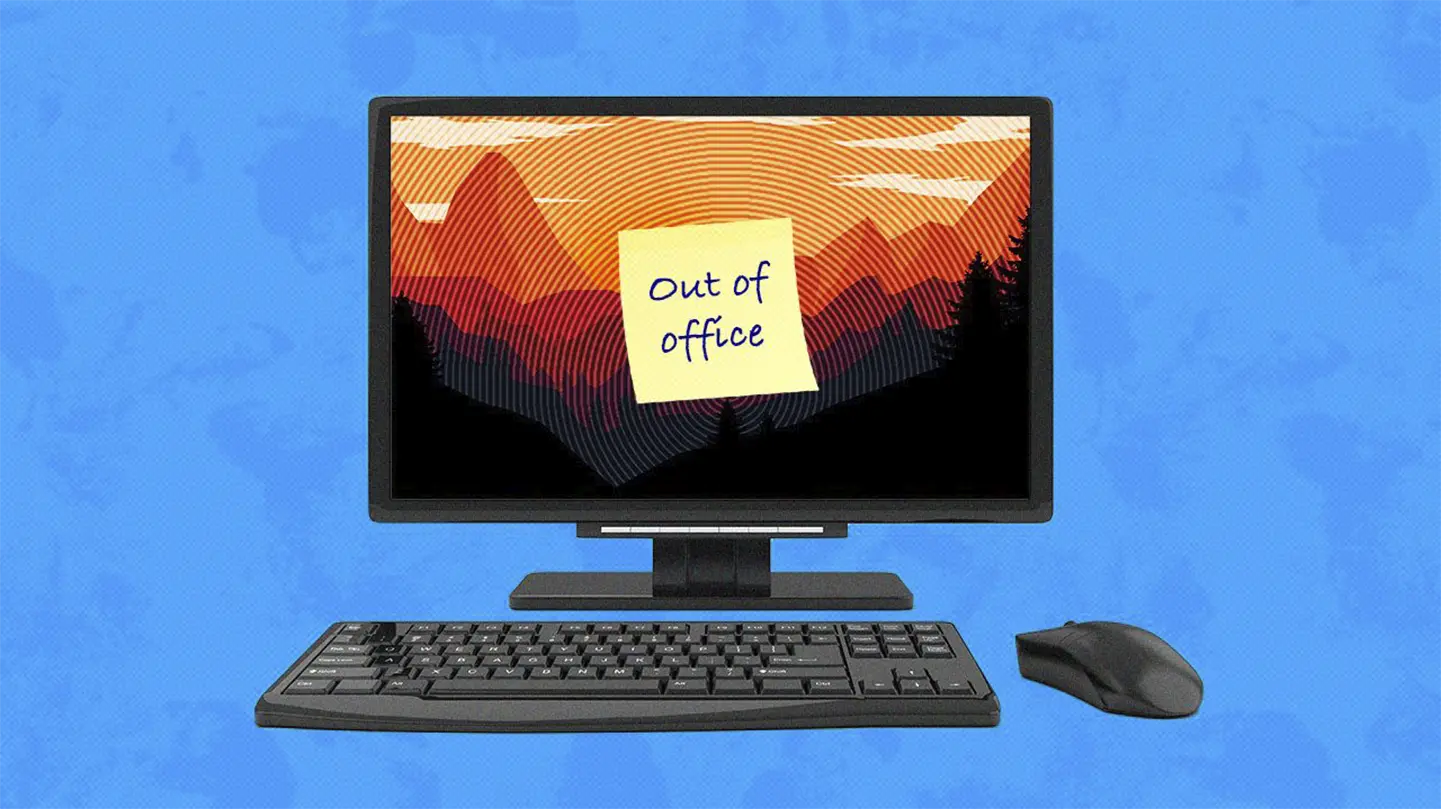Use this holiday entitlement calculator to work out employee holiday allowances
The holiday entitlement for 2025 is
For the full year.
Stop wasting time working out holiday entitlement yourself
With Charlie, your whole team’s holiday allowance is calculated automatically.
Book a demo
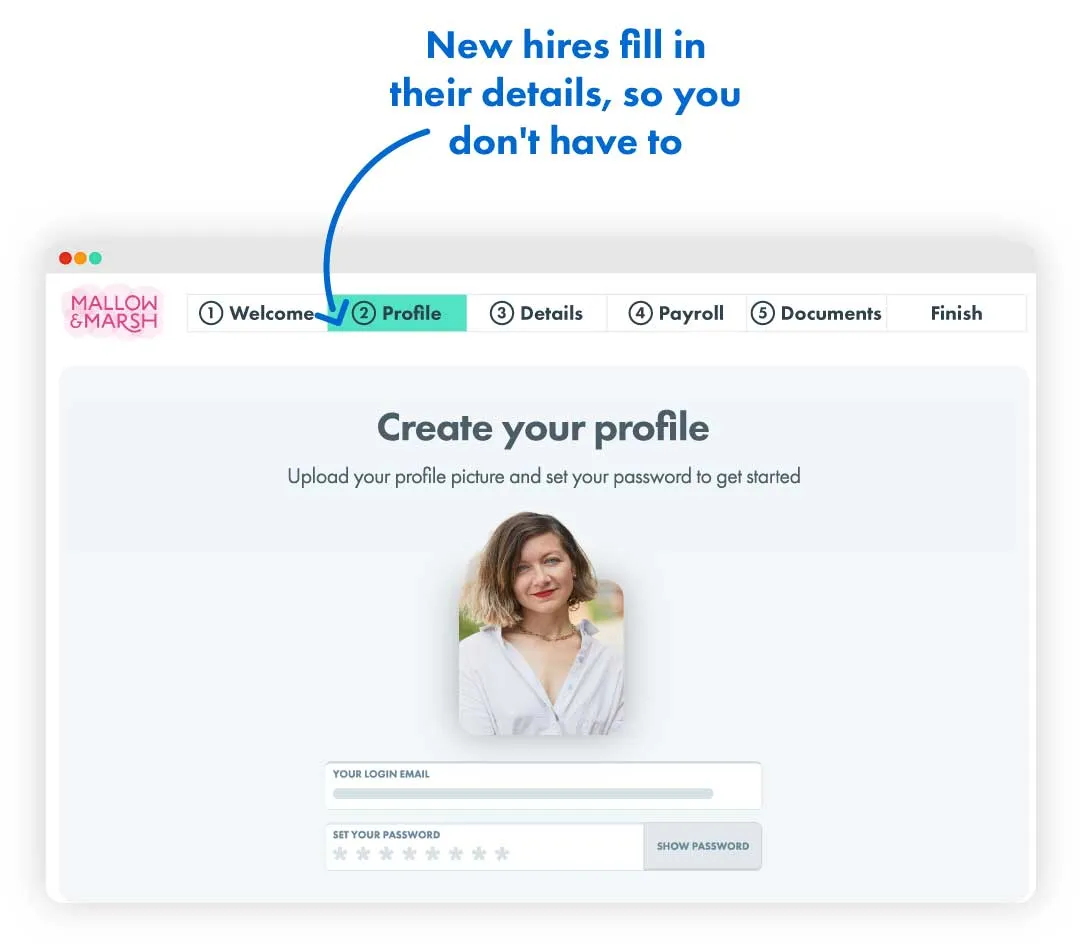
Use this holiday entitlement calculator to work out employee holiday allowances
The holiday entitlement for 2025 is
For the full year.
Stop wasting time working out holiday entitlement yourself
With Charlie, your whole team’s holiday allowance is calculated automatically.
Try for free

Use this holiday pay calculator to work out whether an employee is owed holiday pay when they leave your company
13.00 days of unused holiday, equivalent to
Pro rated for 260 days of employment.
Spending too much time on HR admin?
With Charlie, your can automate manual HR tasks and get tricky calculations done for you.
Start your free trial

Holiday entitlement calculation – all you need to know
How many holidays are you entitled to in the UK?
UK employees are entitled to 5.6 weeks of statutory holiday entitlement, which is equal to 28 days of paid leave if they work at least 5 days a week.
5-day week = 5
Annual holiday entitlement = 5.65 x 5.6 = 28 days
As the employer you can choose to include UK bank holidays in the total or have them on top. Many employers choose to offer more than 5.6 weeks, but that’s the UK minimum annual leave everyone should get regardless of contract type.
The entitlement can however be different if a team member:
-
Works part-time – the holiday entitlement will depend on their working patterns (how many working days they have each week).
- Do shift work or are a term-time worker – for someone working irregular hours, time off is calculated on the number of hours rather than the number of days.
Note that team members who work more than five days a week are still only entitled to the statutory leave limit of 28 days (this is known as statutory leave cap) unless their employer states otherwise.
A time off process that runs itself
Charlie does tricky annual leave calculations for you, for total peace of mind.

Learn how to cut HR admin

Get any question answered

Zero commitment
What is pro rata holiday entitlement?
Pro rata holiday entitlement is determined by calculating the proportion of annual leave an employee is entitled to depending on how much they’ve worked during that year.
It works in different ways depending on the type of worker you have at your company:
-
Full-time employees working five days a week are entitled to a minimum of 28 days
- Part-time employees working a regular pattern (for example, Monday to Thursday with Friday off every week) benefit from the same 28-day allowance, but it’s worked out differently due to their reduced hours
- Zero-hour contract workers also benefit from 28 days, but the calculation of this allowance will be dependent on the number of hours they’ve worked with a yearly average. If they’ve not worked during certain weeks, then the calculation involved the weeks where they’ve been paid.
How do you calculate holiday pro rata?
Calculating holiday pro rata is usually quite simple:
Number of days worked/per x 5.6 (28 days)
It can, however, get complicated depending on a few details such as hours worked or if they’ve started halfway through the year.
Although it’s easier to use the calculator above to work out holiday entitlement and do pro rata, we’ll let you in on how the calculator works if you want to do it on your own.
Calculating holiday entitlement for a team member starting halfway through the year
Let’s say one of your team members joins the company in the middle of the year (June if your leave year runs from January to December) – that means you’ll have to let them know how many holidays they’ve got left for the rest of the year.
Simply work out how many holidays they’ll accrue until the end of the year. Each month, your team member should get roughly around 2.3 days of holidays, which means that in this case, with 5 months left until the end of the year, they would get 13.8 days (2.3 x 6).
According to UK employment law, you’ll need to round up the number, which means they’ll get 14 days.
However, that’s only a rough calculation, and considering most of your team members will start part-way through the year, you’ll want a more sustainable way of calculating their time off and making that information available to them.
That’s where you should look at automating your calculations. With Charlie’s HR software, for example, you can simply enter the start date for your team member and the system will prorate their holiday allowance for you.
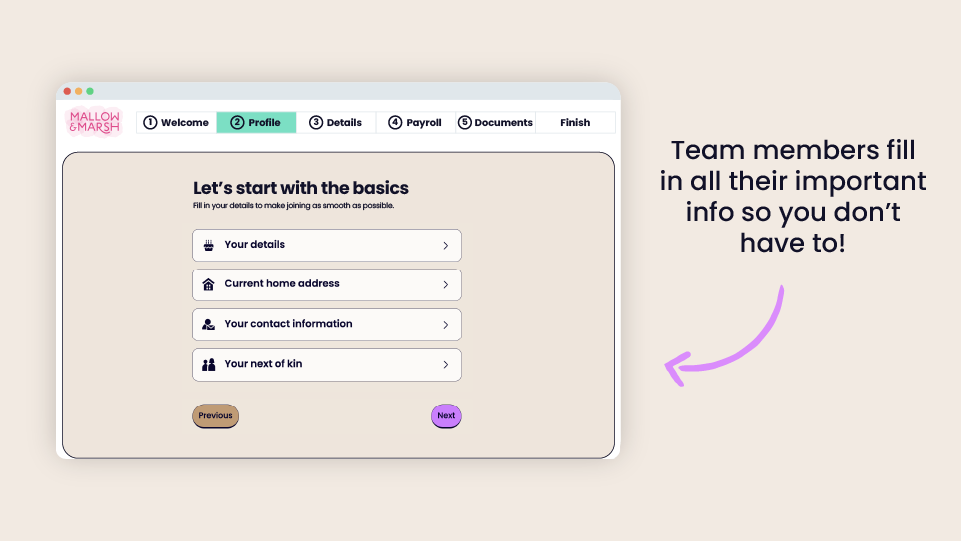
Your team will get their time off information as soon as they join the company, having access to their holiday allowance and being able to request time off all in one place.
Calculating holiday entitlement for an employee leaving during the holiday year
Every time an employee leaves the company, you have to calculate their remaining holiday entitlement. It is important to get this right because failing to give them the remaining holiday they’re entitled to may result in legal action against your company.
You can use this formula to calculate leavers’ holiday entitlement:
Full annual holiday entitlement (in days) x months worked ÷ 12
For example, if you offer 28 days of holiday leave per year, and your team member is leaving on July 1st, it will be:
28 x 6 (months worked) ÷ 12 = 14 days of allowance remaining
N.B.: Remember that from this resulting number, you’ll need to deduce the number of holiday days they’ve already taken in your holiday year!
With annual leave management software like CharlieHR, you can save yourself the hassle of doing these calculations manually. Simply input your team member’s leaving date, and the system will prorate their remaining leave automatically.
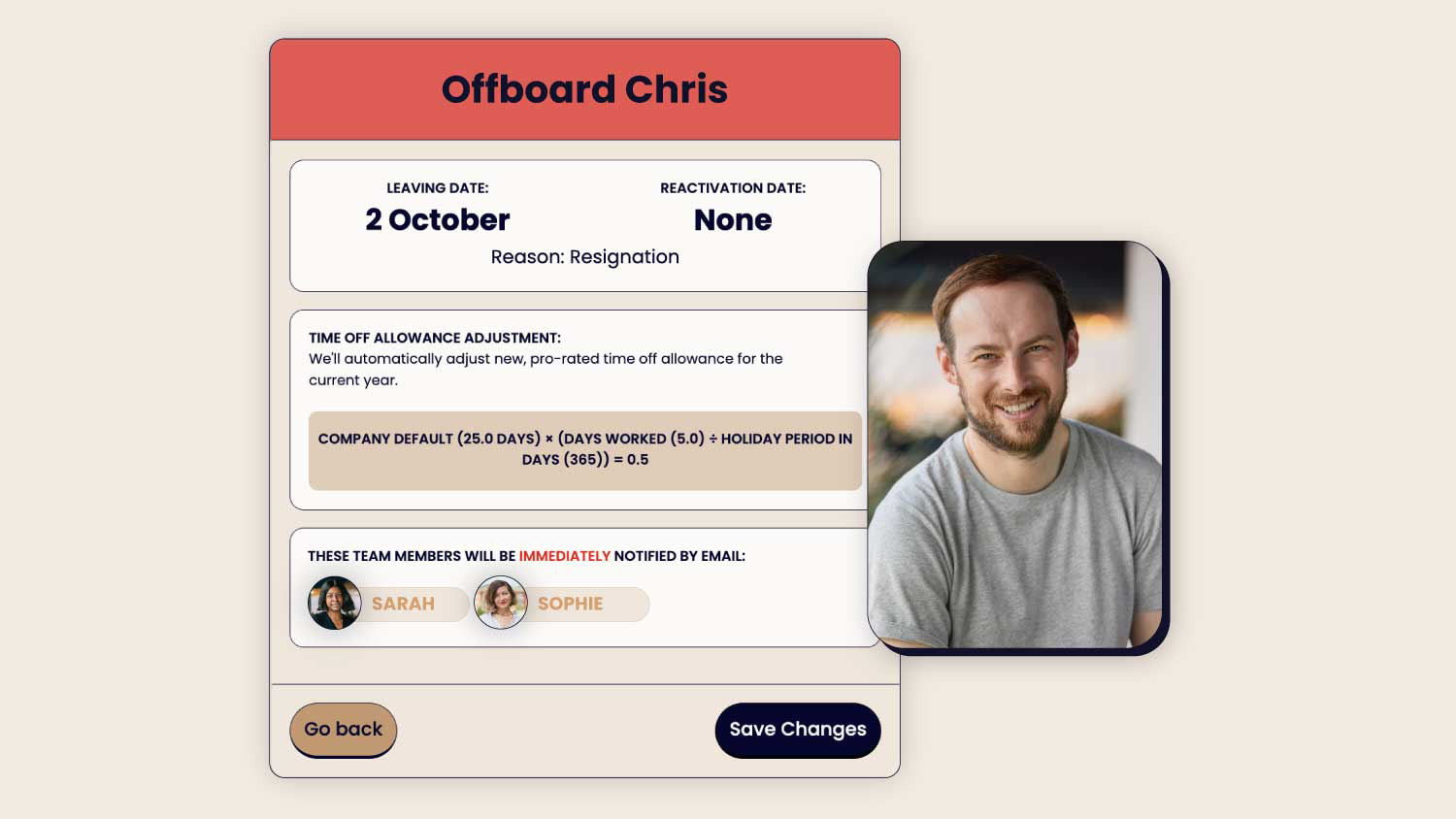
Calculating holiday entitlement for a part-time employee
Part-time staff are entitled to the same amount of holiday as full time workers, but pro-rata. For example, if a team member works 4 days per week, the calculation would be the following: 4 x 5.6 (weeks of statutory leave) = 22.4.
In the UK, these holiday allowances must legally be rounded up (not down) to the nearest half day. So this would amount to 23 days’ allowance.
Calculating holiday entitlement for employees working in shift (days and hours)
Working different patterns or working in shifts, such as people who work in hospitality or in construction, involves a different kind of calculation as it will involve the hours worked during a period of time rather than the days.
In this instance, calculating holiday entitlement will mean working out the average hours worked in the previous 12 weeks to work out how much holidays they’re owed as they usually have a pay-check that can be different month on month. The same goes for the holidays accrued each month.
FAQ for pro rata holiday entitlement in the UK

Bank holidays don’t have to be included in your calculations – you may wonder whether UK bank holidays should be included in your total allowance for your employees, and whether a part-time employee is still entitled to an additional day if they don’t work on Mondays when Easter Monday comes around.
Remember that it’s up to your holiday policy to determine whether bank holidays make part of your worker’s allowance – it’s 8 days in total in the UK, so think about what you want to decide for your business.
For part-time workers, for example, who have a working pattern where they don’t work on Mondays, they simply won’t work on Easter Monday as they usually do – If you want to ensure they work on specific bank holidays (let’s say Good Friday), you will need to specify it in their contract. You could, for example, simply allow for a 28-days allowance that don’t include bank holidays.

It largely depends on the allowance you’ve set for the year and whether your team members work part-time, zero hours or full-time.
Just keep in mind that there is always a minimum required by UK employment law. For a full-time employee, the minimum is 28 days.
You can do the maths based on when your team member started, to see how much they’ve accrued so far, or you can simply use our calculator or HR software to find out.
Some extra details to note for accruing holidays:
- Workers will still build it up if they’re on paternity, maternity, adoption or sick leave
- Zero hours workers will have a pro rata amount that’s calculated in hours

Carry over means carrying over holidays from one year onto the next, especially if you haven’t been able to take all of your holidays or if you’ve been ill or pregnant.
You can either allow your team members to carry over a specific amount of leave into the next year if they haven’t managed to take everything in one go, or you can implement a policy that doesn’t allow for carry over.
It’s completely up to you what you decide to do with the time off for your team members. Find out more in our guide on carry over holidays.

There are a few terms that might feel a bit confusing when you’re not familiar with them. Here’s an overview of what they mean:
-
TOIL means time off in lieu - the employer offers time off when people have worked more hours as an alternative to pay, for example, over-time or even if they’ve worked on a bank holiday that’s normally included in their allowance.
- PILON means payment in lieu of notice - that means employers can give the amount of notice they owe to the employee without them having to work their notice period. This is usually paid in one lump sum.
Automating holiday entitlement calculation for all team members
Using a calculator like this one is a pretty good solution when you don’t want to waste your time with spreadsheets.
However, it’s yet another tab you need to open every time you need to calculate holiday allowance for your team members, and then record the adequate amount somewhere else.
That’s where time off automation might come in handy to remove yourself from the manual process completely.
With HR software, allowances are calculated in one click, giving you the answer you need at the tip of your fingers.
With an HR tool like Charlie, you can also choose to manually adjust the amount of time off your team member gets – that can be really useful if they’re due any time in lieu or any carry over leave that’s not included in their normal allowance at the time they leave.
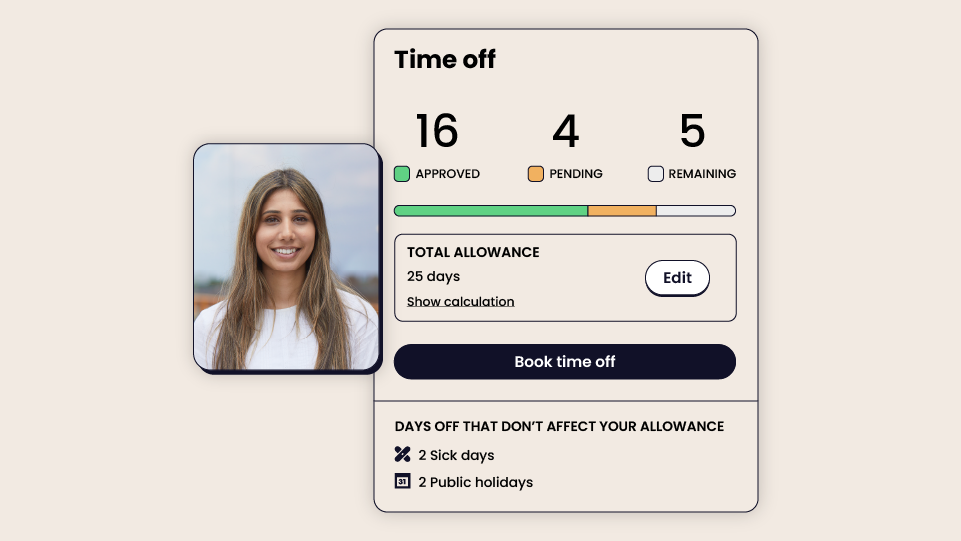
With an HR tool like Charlie, you can also choose to manually adjust the amount of time off your team member gets – that can be really useful if they’re due any time in lieu or any carry over leave that’s not included in their normal allowance at the time they leave.
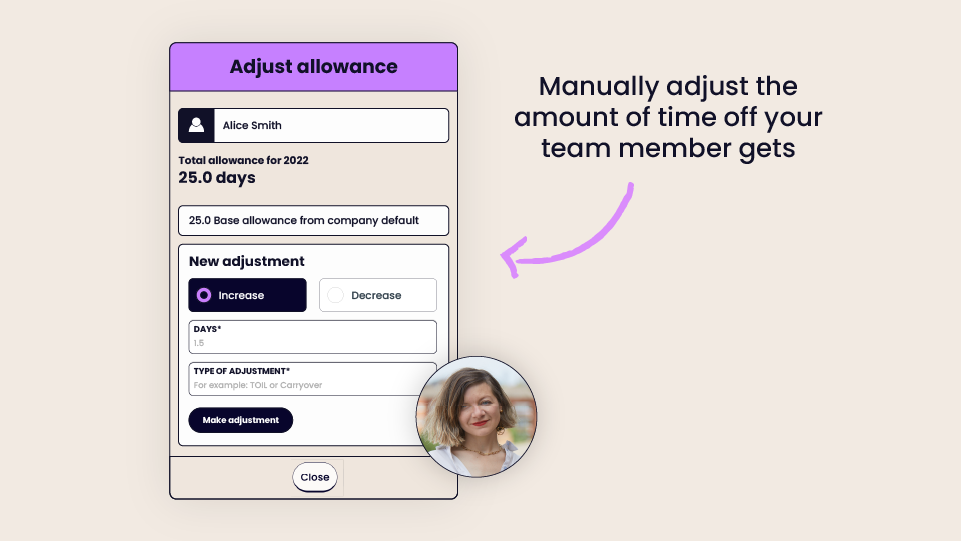
Book a free demo today
Save yourself hours every week – and spend it building a happy, high-performing team instead
Learn how to cut HR admin

Get any question answered

Zero commitment
How do you calculate holiday pay for your team members?
This process – automated through our holiday pay calculator above – is really useful if you want to calculate how much a team member is owed when they leave your business.
This payment is called Payment in Lieu of Notice (PILON) and allows you to pay your team members for their remaining holidays – which can be useful in case of redundancies or if you’re putting an end to someone’s probation and don’t require them to work for you anymore.
In terms of calculating annual leave, you can also find out how much annual leave is owed to team members in their notice period.
This calculator can also tell you if a team member has taken more than their remaining annual leave entitlement. It’s important to note that the procedure for dealing with this scenario should be outlined in an employee handbook or contract. Without this, the company cannot demand payment for leave taken.
In terms of how the calculation can be done manually, here are a few pieces of information you need to collect:
- Their start date and end date, to understand how much holiday they have accrued during that period depending on your company’s financial year and holiday allowance.
- Their salary, to work out how much they get paid daily and multiply it by the holidays they accrued.
- How many holidays they took so far, to deduct it from the holidays accrued so far.
- Any TOIL (Time off in Lieu) or carry over (if any) to add on top of this.
FAQ for holiday entitlement in the UK

There are many different types of leave, but the same rules don’t apply to all of them.
In the UK, annual leave means paid time off that team members are entitled to, but depending on the circumstances, they may be entitled to:
-
Sick leave – where they can be eligible for Statutory Sick Pay (SPP) for up to 28 weeks and where your company can craft a policy to offer more, but cannot offer less. Have a look at our guide on long-term sick leave for more guidance.
- Maternity and paternity leave – when team members become parents, your company can also build a policy to offer secure income and time off for both parents.
- Other types of leave – there are many different types of leave including bereavement leave or jury duty. Whereas some types of leave have rules in the UK, others are at the employer's discretion. That’s where we could recommend having clear rules on what can be done depending on each situation so you don’t deal with it on a case-by-case basis.
Sick leave and other types of leave do not carry over into the next year, however, it is possible for the employee to carry over holidays if they have not been able to take their leave due to being sick or having a child.
Have a look at our guide to understand what annual leave is in the UK.

When it comes to days off at your business, it’s always better to have clear policies to avoid operating on a case-by-case basis.
First, this ensures all team members are treated fairly, and second, it’s a better way for you to streamline your processes and make sure everyone is clear on what they can and cannot do.
Here are a few examples of where HR policies can be useful when it comes to calculating holidays:
-
Carry over – with 28 days being the minimum, team members can only carry any day over 28 days of untaken leave in the next year. So, if you offer more than the statutory minimum allowance, you should seriously consider allowing your team members to carry over some leave. If you’re using an HRMS platform like CharlieHR, all you need to do is to set the number of days you allow your team to carry over, and the platform will automatically roll that time to the new year for all team members.
- Part-time workers – part-time workers have the same rights as any full-time employee in terms of pay, pension, training, promotion as well as holidays. However, you’re entitled to calculate their holidays pro rata as they work less hours than a full-time employee. You can choose to go for the minimum or offer them more.
- Bank holidays – as an employer, you can decide whether your team will work on bank holidays or not, or you can simply decide to include public holidays in your annual leave allowance. Make sure the process is outlined in your HR policies.
- Notice periods – when a team member joins, it’s important you include a notice period in their contract of employment, so you can not only correctly calculate their holiday entitlement but also have enough time to find their replacement.

If you’re not sure how to do it on a long-term basis, there are a few solutions you can try when it comes to calculating holiday entitlement pro rata for your team. Here’s what’s in store if you want to go down that route:
-
Excel holiday tracker – this is a great way to input your own formulas and work it out, but note this can be very time consuming and prone to human error
- Adding annual leave to outlook calendar– that’s more in terms of keeping track of whose off and when so you don’t get carry over and allowances wrong
- Staff holiday planner – as part of an HR software, a staff holiday planner feature can help you plan your team’s members leave and does all the pro rata calculations for you
How do I keep track of all types of leave?
Keeping track of all types of leave – including annual leave – can be done in many different ways.
You can choose to do it manually by putting together a spreadsheet and saving it in different places on your drive to make sense of it all. However, remember that this will be a lengthy process, prone to human error.
Not only will you have to go back to the spreadsheet and do the calculations every time, but you’ll also have to fix broken formulas and ensure you got it all right.
It might work in the beginning but may become too much as you grow and have to do this frequently.
Instead, you can choose to automate the whole process by using HR software – have all your time off recorded in one place and your calculations are done in no time with a click of a button.
The plus side is your team members can even self-serve on the platform and request time off that you can approve. Onboard or offboard in a few clicks and never think about it again. Try CharlieHR for free today to find out more.
Book a free demo today
Save yourself hours every week – and spend it building a happy, high-performing team instead
Learn how to cut HR admin

Get any question answered

Zero commitment




